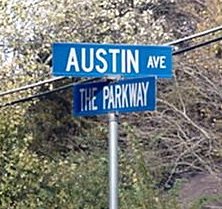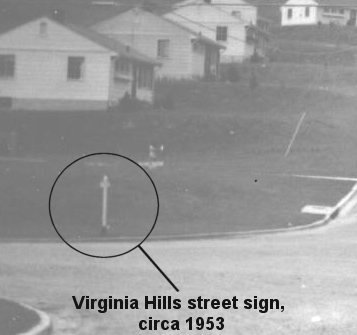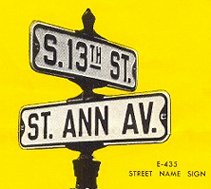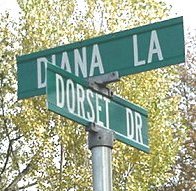
The original Virginia Hills street signs were installed by the developers, Banks and Lee; by 1958 some were missing and the rest looked "shabby." Fairfax County had not yet assumed responsibility for such normal services as street lights and signs in Virginia Hills. Therefore, at the November 1958 meeting of the Citizens Association, members approved a motion "that the Executive Committee investigate the overall cost of getting street signs installed and have a ballot printed in the next issue of the Echo, to determine whether enough people would be interested."

The ballot did not appear in the December Echo, but the matter was not forgotten. It was, however, overshadowed by the campaign to get street lights for Virginia Hills. In April 1959, the Executive Committee of the Association proposed deferring action on street signs because of the street light initiative and an insufficient balance in the treasury. This was agreed to in the April Association meeting, but a motion did pass that the Association direct a letter to local real estate agents asking for a donation for the signs. That came to naught.
The cause of new street signs was furthered when officials from the Penn Daw Fire Station notified the Association in May 1958 that "they would have a hard time finding some of the homes in Virginia Hills area because of the poor condition of the present signs." The Echo suggested that a door-to-door campaign to solicit contributions might be the answer, and the Association agreed at the June 1959 meeting to ask during the Fall membership drive for an extra donation of $1.00 which would be dedicated to the new signs. The Association approved $570 for signs in its 1959-60 budget. Responsibility for the project fell to Bill Bradley, newly-elected Chair of the Local Affairs Committee.
Mr. Bradley's research revealed that once Virginia Hills had purchased the signs and the sign poles, the County would install them and maintain them. He determined that 47 locations would require street signs, and Lyle Signs, Inc. of Minnesota (with the Municipal Sales Company of Silver Spring acting as agent) would provide them for $373.50. The poles could be obtained locally and would cost approximately $130. The signs would have a white background with black lettering.

It's interesting to note from the list of locations the streets that were different in 1960. There were an East and West Gentele Court, an East and West Austin Avenue, and an East and West Heather Court. Pike Road was then Pike Branch Road. Hillview Court did not then exist.
The remaining difficulty was obtaining funding for the signs. By December 1959, the 478 members of the Association had contributed only $311.50. Consequently, the Association agreed to make up the difference from general funds and the $75 surplus remaining from the street light initiative.
The signs were ordered in May of 1960 and received at the end of June. Mr. Bradley had already purchased the 47 poles and painted them silver. The County dug the holes and emplaced the poles. Virginia Hills residents assembled the signs under Mr. Bradley's direction and attached them to the poles. Sign maintenance was now the County responsibility.

Ultimately, the County replaced the signs with the green and white ones (an example or two of which are still around), and then, in the late 1990s, with the larger blue and white signs.
The information for this history is drawn from the Echo from the period 1958-1960, the original documents for the purchase and receipt of the signs, and supplementary information provided by Mr. Bradley. Please contact Doug Boulter if you have additional information about the signs.